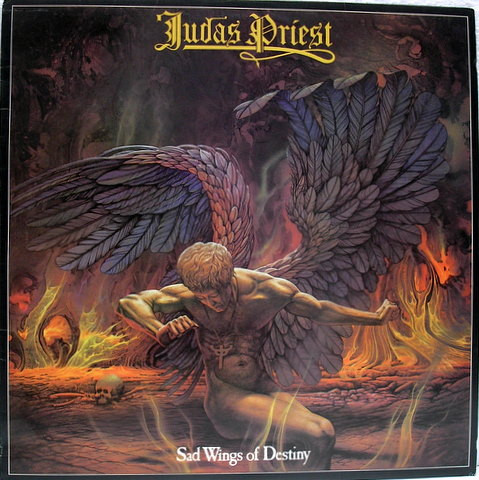„Dreamer Deceiver“, from Judas Priest’s 1976 album Sad Wings of Destiny, is a mystical, dreamlike ballad that blends fantasy, escapism, and a sense of transcendence. Unlike the aggression and horror of „The Ripper“, this song explores a surreal, almost psychedelic journey, using ethereal imagery and emotional depth to create an otherworldly experience.
With its slow, atmospheric build-up, Rob Halford’s haunting vocal delivery, and soaring climaxes, the track hypnotizes the listener, pulling them into a dream realm where a mysterious figure—the Dreamer Deceiver—acts as a guide to the unknown.
This song is deeply symbolic, drawing from mythology, spiritual journeys, and cosmic themes, making it one of Judas Priest’s most enigmatic and mesmerizing compositions.
Overview
At its core, Dreamer Deceiver explores:
- The theme of an otherworldly guide offering escape from reality.
- A journey into dreamlike dimensions, possibly influenced by mysticism or psychedelia.
- Themes of deception—whether the dreamer is a savior or a manipulator remains ambiguous.
- A slow, haunting musical build-up that evolves into a powerful climax.
The song blends poetic fantasy with deep emotional expression, making it one of Judas Priest’s most unique and haunting tracks.
Narrative Structure
1. The Arrival of the Dreamer (Mystical Introduction)
- The song begins with soft, hypnotic guitars, immediately setting a dreamlike, trance-inducing atmosphere.
- The narrator introduces the Dreamer Deceiver, a mystical being:
„Standing by my window, breathing summer breeze…“ - The imagery is serene, peaceful, and almost divine, suggesting that the Dreamer Deceiver is a supernatural entity, inviting the listener into his realm.
- Themes: The song establishes a dreamlike escape, drawing the listener into another dimension.
2. The Journey (Ethereal Flight & Transformation)
- The Dreamer takes the narrator on a cosmic journey:
„Riding on the wings of the night…“ - The sensation of flight is powerful, evoking imagery of soaring through galaxies, ascending beyond earthly limitations.
- The lyrics suggest a feeling of freedom, ecstasy, and enlightenment, as if the Dreamer is offering an escape into the unknown.
- The music mirrors this progression, with Halford’s vocals growing more powerful and emotional, making it feel like a transformation is occurring.
3. The Climax (Ecstasy or Deception?)
- As the music builds, the lyrics hint at a deeper, possibly darker revelation:
„He gave to me his magic sign…“ - This could imply a spiritual awakening or an initiation into something more mysterious and dangerous.
- The ambiguity of whether the Dreamer is truly a benevolent guide or a deceiver is left unresolved—he could be a prophet, an alien, a sorcerer, or even death itself.
- The vocals reach their peak, with Halford’s wails sending shivers down the spine, making the experience feel transcendent and overwhelming.
4. The Departure (Disillusionment & Uncertainty)
- The final lines leave a sense of mystery and longing:
„Then he let me go…“ - The Dreamer Deceiver disappears, leaving the narrator changed but unsure of what just happened.
- Was it all a dream? A lie? A genuine mystical experience?
- The song fades into a sense of emptiness, preparing for the explosive sequel, Deceiver.
Themes & Symbolism
1. Mysticism & Otherworldly Beings
- The Dreamer Deceiver resembles figures from mythology and religion, like:
- Lucifer as the Lightbringer, offering knowledge but also deception.
- A shaman or spiritual guide, leading the soul to new realms.
- An extraterrestrial being, taking the narrator to another dimension.
2. Dream & Reality Blurring
- The song plays with what is real and what is illusion.
- The narrator is completely entranced, making the listener question:
- Is this a spiritual awakening or a manipulation?
- Is this freedom or just another form of control?
3. The Deceiver Motif (Foreshadowing the Next Song)
- The title itself suggests the Dreamer may be a false prophet.
- This concept is further explored in the next track, Deceiver, where the dream shatters.
4. The Sensation of Flight & Transformation
- Flying symbolizes breaking free from limitations, reaching new levels of consciousness.
- The Dreamer offers liberation, but at what cost?
Musical & Emotional Impact
1. The Soft, Hypnotic Beginning
- Delicate acoustic guitars create a serene, almost meditative atmosphere.
- Halford’s soft, soothing vocals lull the listener into a dreamlike trance.
2. The Gradual, Unsettling Build-Up
- The music subtly intensifies, making the listener feel as though they’re ascending with the narrator.
- The delayed climax mirrors the slow realization that this dream may not be what it seems.
3. The Explosive, Emotional Climax
- Halford’s voice soars into the heavens, delivering one of his most emotional and haunting performances.
- The powerful wails convey ecstasy, revelation, and unease at the same time.
4. The Abrupt, Hollow Ending
- The song doesn’t fully resolve—it fades out into uncertainty, making the listener feel abandoned, just like the narrator.
- The transition into Deceiver emphasizes that the dream may have been a trap all along.
Legacy & Influence
- Considered one of Judas Priest’s most atmospheric and mysterious songs.
- Showcases Halford’s incredible vocal range, proving he can captivate even in softer, ethereal settings.
- Prefigures the grandeur of later Priest ballads, influencing songs like Beyond the Realms of Death and Dreamer’s Disease.
- Highly regarded by fans, often seen as an underrated gem in their early discography.
- Explores mystical and psychedelic themes that influenced later bands in progressive and power metal.
Final Verdict
„Dreamer Deceiver“ is a hypnotic, mystical masterpiece, leading the listener into a world of beauty, wonder, and deception. With its slow, mesmerizing build-up, soaring vocals, and ambiguous ending, it captures the feeling of stepping into the unknown, only to realize too late that not everything is as it seems.
A dreamlike ballad that lures you in with beauty, only to leave you questioning reality.



